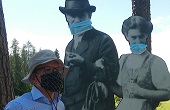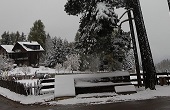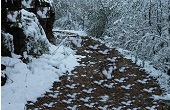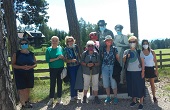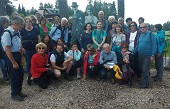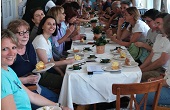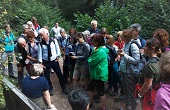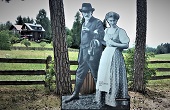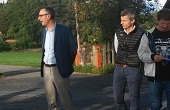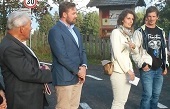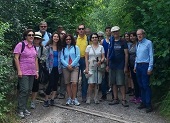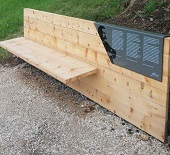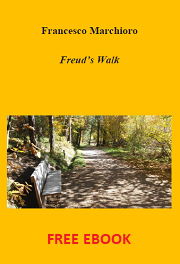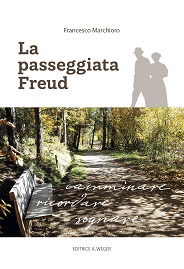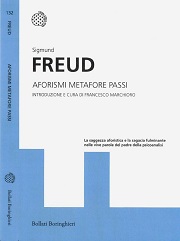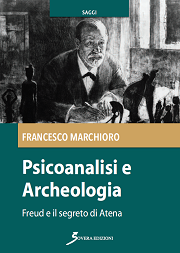Freud
a path
through the woods
As part of Francesco Marchioro's project, the Renon Council and Imago Ricerche association have dedicated the main path of Renon, the number 35, running from Soprabolzano to Collalbo, to Sigmund Freud, the founder of psychoanalysis. This commemorates the 150th anniversary of his birth (6th May 1856 - 6th May 2006) and the path has been named "Freud-Promenade".
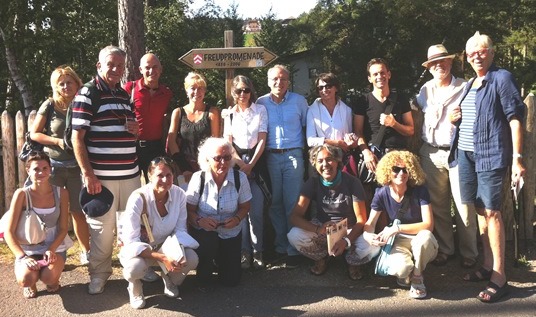
But what meaning does a walk in the footsteps of a great personality and genius of the 19th century have today? Philosophy, wisdom and flights of thought came into being thanks to the motion of walking and so, when we wish to free ourselves from duties and places, pain and fear, we walk along lanes and through gardens, parks and trees, amidst leaves and the wind's sighs in the hope that they will bring carefree thoughts to surprise and gently fascinate us. And when all of this happens in a serene sylvan setting we can give in to the genius of the place and capture the silent telling of tales, the fabric of impressions, the fleeting shadow of memory, the pleasure in a mobile glance, passionate and dreaming.
Now the genius loci of Renon has been enriched by allure of the interpreter of dreams, Sigmund Freud, to whom this main path is dedicated - that path number 35 that walkers and tourists have flocked to for decades in search of cool and woodland voices. We may even come across the genius of Vienna amidst the silence and countryside of Renon if we are capable of abandoning ourselves to the atmosphere of the new old path, which the founder of psychoanalysis surely took and admired along with his family on holiday all those years ago.
The route that the Renon path takes is clear and allows glimpses and visions, shadows and colours that only those who know how to walk with imagination and recollection, with "the ear tuned to foliage and ancient stone", in the words of Georg Trakl regarding the gardens at Mönchsberg, may understand.
And how did this link between the ideal place for Bolzano residents to go for a bit of 'Sommerfrische', or summer cool, and the genius tourist Sigmund Freud come about? In a letter dating Febrary 1911, he reveals to Carl Gustav Jung «[Next summer] I need a place where I can be alone with a forest nearby». So, before Easter, on Friday, the 14th of April, he leaves Vienna in the company of his friend and pupil Sandor Ferenczi and makes a quick tour lasting just six days to find a suitable place around Trento and Bolzano. He returns to Vienna the following Thursday and his research produces excellent results in the form of Renon near Bolzano. Consequently, on the 9th of July, Freud sets off from Karlsbad, where he was staying to recover from a bout of 'American colitis', and joins his family at Collalbo. This is where the Freuds celebrate their silver wedding anniversary, on 14th September - the enjoyment of their holiday thus being enhanced by love and affection.
As announced by the letter mentioned above, Totem and taboo were created. This is a work started from afar, but it was at Collalbo that Freud wrote L'orrore dell'incesto, the first essay in the work, which took longer to write than predicted, and was not finished until May 1913.
This work originated amidst a happy and restful atmosphere. On Renon the woods open up to reveal superb views of the whole of the Dolomites, of mountain passes and peaks that he reached on his frequent travels on several occasions, weaving pleasant excursions into the web of ancient paths. One of Freud's sons, Martin, tells: «The walks with my father were very exciting and entertaining, because they were like a marvellous story, rich in emotion».
This is why the Freud path has the air of an affectionate testimonial to the presence of the illustrious man from Vienna and walking through its forests can be an original and atmospheric route still today.
The 'Freud path' places Renon in one of a famous series of national and internation cultural paths (the Way of St. James, the Rilke Trail to Duino, the 'Via della Musica' of Milan, the Dürer path to Salorno etc.), with the subsequent increase in value of the place and its 'geniuses', open to all those looking for peace and quiet and culture despite being, and especially when, on holiday. Let ourselves be captivated by nature and its history, images, ideas and emotionally involving tales. Only in this frame of mind is it possible to experience the Freud path and encounter his genius amidst nature, which thus becomes a display of beauty, dialogue and the art of balance, parabola of mythical imagination that influences man's consciousness like a work of transformation.



